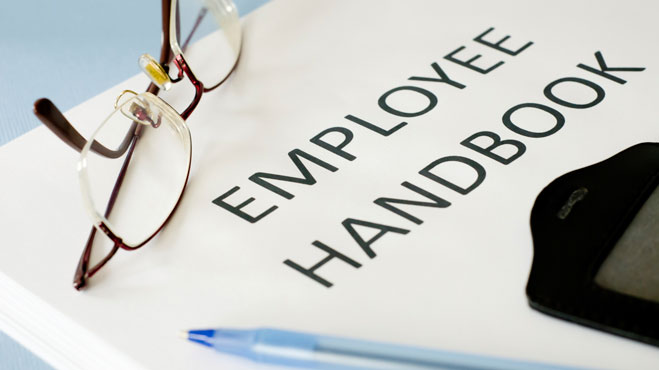
HR Policies that Could be Missing from your Business
There’s no law that says you must create an employee handbook. In fact, some business owners who have such a small number of employees tend to forget about human resource (HR) manuals entirely. After all, does anyone really read those things.
While you may not think having official HR policies or handbooks is necessary, you may find that they will save you plenty of headaches down the road. Policies set expectations for employees and will ensure that all of your employees in all departments are on the same page when it comes to arrival times, dress codes and other company-wide rules and legislation.
If you’re planning out your policies or considering writing a full handbook, make sure you don’t leave these essential HR policies out. Though they may seem obvious or inconsequential, you need to make sure you spell out these policies once and for all, lest you find yourself defending against an unfair dismissal charge.
Equal employment opportunity
The best organisations are the ones that employ people from all walks of life and treat them all fairly and with the utmost respect. Discrimination against employees, potential candidates and the general public should never be acceptable, and your employees need to know this.
Some people, however, have trouble recognising discrimination, which is why your policy needs to outline the different forms of discrimination and what to do if an employee witnesses one of the forms. Discrimination can be defined as direct, indirect, sexual harassment and bullying and can be directed at employees as well as clients.
The policy should outline what these types of discrimination look like, how employees can report discrimination when they see it and what sort of actions will take place once discrimination is identified. This will make it abundantly clear to your employees that you do not tolerate any type of discrimination and encourages them to report it if it does happen.
Privacy
Privacy is a hot topic nowadays, and employers need to be sure that employees know what is okay to share and what is not. It extends to an employee’s individual privacy, such as an employee’s health records.
Most privacy codes derive from the Privacy Act of 1988, which should be used as a reference guide for employers when making their privacy policies. Employees need to be aware of what information is considered private and how employers may go about collecting some information, rather than asking an employee.
Privacy codes also outline what information employers should not collect – ethnicity, sexual orientation, religious affiliation – and under what circumstances this type of information can be collected under. Your employees will feel more comfortable working with you and trust you to keep their sensitive information private.
General code of conduct
You may feel that telling your employees to behave themselves is sort of a no-brainer. Do you really need to tell them not to tell company information to outside sources or not to bully one another in the workplace?
The truth is you do. While this should be common knowledge for everyone, it still needs to be outlined in the code of conduct. This part of your policy explains how you want your employees to act while at work and what sort of actions will be taken against them should they fail to conduct themselves in a manner in line with your policies.
The code of conduct usually integrates laws and statutes, such as following the Privacy Act as well as the Freedom of Information Act, in with general rules. The code often answers to the company’s mission statement and general values and outlines who will be responsible for administering discipline if any rules are broken. This gives employees a concrete vision of the chain of command in your organisation.
Types of employees
No matter what type of business you own, you probably have a mix of employee types working for you. Some are part-time; others are full time. Some are independent contractors and freelancers that work for you on an as-needed basis.
While there’s nothing wrong with having these types, it is important that you define each one and what qualifies an employee as part of one group and not another. For example, when does a contractor become a part-time employee and when does a part-time employee become a full-time employee.
Each industry is different. Even within companies, departments have different definitions of these terms. That’s why it’s important to outline each position and what it means to be one or the other. This will also help you establish when an employee works overtime.
Dress code
Most business owners – regardless of industry – often assume that dress codes are common knowledge. Skirts should be knee-length and tops should be modest (that goes for men wearing v-necks as well). If a uniform is required, all employees should be wearing the uniform.
But what about the finer points? For example, will you have a “casual Friday” and allow employees to wear jeans and open-toed shoes? Will you allow employees to dye their hair non-traditional colours such as blue or green or allow them to show off their tattoos? If your employees must wear a uniform, how much can they tweak it? Can they wear bold or dangling jewellery or pins and patches on shirts?
An employee’s attire is a reflection of not only themselves but of the company as well. If you want to reflect a certain image, be sure to outline dress code policies before someone shows up to work with a rainbow-coloured mohawk.

Social media and internet policies
In this digital age, it’s safe to assume that all of your employees have some sort of social media presence. Whether they’re on Facebook, Twitter or Instagram, your employees need to be aware of how they present themselves while their online and understand how their actions can reflect badly on the company.
Employers are now starting to realise how much of a liability social media can be – especially if employees are bad-mouthing the company or sharing private company information. Therefore, it’s necessary to lay down some ground rules for social media and state exactly what you expect of all your employees. They should be aware of what is and what is not acceptable online and any consequences that will result if they are caught violating company policy.
There should also be policies regarding the types of activities employees can be doing and what websites visiting while on a work computer. Some employers adopt a straight no-social-media policy while others block certain websites from being viewed.
To make things easier, print out the social media and internet policy and have all employees sign it. This will ensure that all your employees have seen the policies and it will be up to them to read them. No matter what, you cannot be charged with unfair dismissal if someone breaks the policy.
Redundancy policies
Overtime, your business will grow and change. Some of the jobs currently filled may become obsolete in another five years and may be required to be made redundant.
The Fair Work Act outlines exactly what is to be done in cases of redundancy (usually a severance must be paid to the employee), but there are some exceptions. Small businesses and and casual employees may be exempt from this ruling. Even though you may feel that this policy is already outlined in the law, it is important that you further define it in your policy.
You will need to know if you qualify for any exemptions, and if so, how will those exemptions affect employees? Speak with your HR Consultant and create a policy to reflect what is to be done in the event of redundancy. You might try to move employees to different departments or revise job titles and jobs to make a new position for an employee.
These are just a few examples but they are often the most commonly overlooked policies. To check what other HR policies could be missing from your handbook contact us or download our brochure.
Download Flexi Personnel HR Consultancy Brochure
What other policies have you forgotten or overlooked? Share your thoughts with us!





